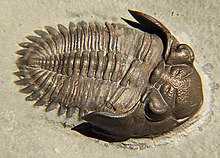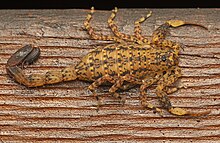Arachnomorpha
| Arachnomorpha Temporal range: | |
|---|---|
 | |
| Fossil of Bellacartwrightia calliteles, a trilobite | |
 | |
| Lychas variatus, a scorpion chelicerate | |
| Scientific classification | |
| Domain: | Eukaryota |
| Kingdom: | Animalia |
| Phylum: | Arthropoda |
| Clade: | Arachnomorpha Lameere, 1890 |
| Subgroups | |
| Synonyms | |
| |
Arachnomorpha is a proposed subdivision or clade of Arthropoda, comprising the group formed by the trilobites and their close relatives (Artiopoda), Megacheira (which may be paraphyletic) and chelicerates. Under this proposed classification scheme, Arachnomorpha is considered the sister group to Mandibulata (including insects, crustaceans and myriapods).[1]
The arachnomorph concept has been challenged by suggestions that the artiopods are more closely related to mandibulates, forming the clade Antennulata instead.[2][1]
There is no consensus as to assigning Arachnomorpha a formal Linnean rank.
Classification[edit]
Arachnomorpha Lameere, 1890 [= Arachnata Paulus, 1979, = Palaeopoda Packard, 1903]
- †Nettapezoura
- †Dicranocaris
- †Trilobita Walch, 1771
- †Megacheira Hou & Bergstrom, 1997
- †Strabopida Hou & Bergström, 1997
- †Aglaspida Walcott, 1911
- †Cheloniellida Broili, 1932
- Chelicerata Heymons 1901
- Family †Sanctacarididae Legg & Pates, 2017
- Class Pycnogonida Latreille, 1810
- Clade Euchelicerata Weygoldt & Paulus, 1979
- Family †Offacolidae Sutton et al., 2002
- Clade Prosomapoda Lamsdell, 2013
Phylogeny[edit]
Using fossil data, Bergström & Hou (2003) gave an outline of arthropod relationships emphasizing trilobitomorphs (a group that includes trilobites and trilobite-like animals).[3]
| ||||||||||||||||||||||||||||||||||||||||
References[edit]
- ^ a b Aria, Cédric (2022-04-26). "The origin and early evolution of arthropods". Biological Reviews. 97 (5): 1786–1809. doi:10.1111/brv.12864. ISSN 1464-7931. PMID 35475316. S2CID 243269510.
- ^ Gerhard Scholtz & Gregory Edgecombe (2005). "Heads, Hox and the phylogenetic position of trilobites". Crustacea and Arthropod Relationships. CRC Press. pp. 139–165. CiteSeerX 10.1.1.130.2585.
- ^ Bergström, J. & Hou, X. G. (2003). "Arthropod origins" (PDF). Bulletin of Geosciences. 78 (4): 323–334. Archived from the original (PDF) on 2016-03-04. Retrieved 2014-03-03.


 French
French Deutsch
Deutsch